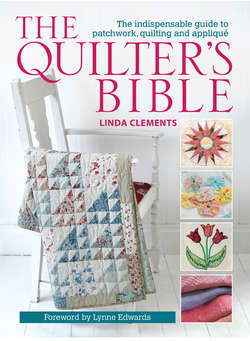Читать книгу The Quilter's Bible - Linda - Страница 38
На сайте Литреса книга снята с продажи.
Using the Right Needle
ОглавлениеBefore sewing you need to check you are using the right needle for your fabric. If you use too fine a needle in thicker fabrics it will break: use too thick a needle in a fine fabric and it will punch holes that will weaken the fabric. Generally, use larger needles for thicker threads and finer needles for thinner threads.
Needles are made of high carbon steel wire and, to resist corrosion, are plated with nickel, gold, platinum or titanium alloys. Needle sizes are in metric (European) and universal (American). For example, for a needle size 80/12, 80 is the metric size and 12 is the universal size (see the needles table in the Useful Information section). The higher the number, the thicker and longer the needle.
Needles are given various names that reflect their function or characteristics. Embroidery, or Crewel needles, are sharp, pointed needles with a longer eye than Sharps, making threading thicker threads easier. Betweens, or Quilting needles, are shorter than Sharps or Embroidery, with a small round eye and are good for detailed work on slightly heavier fabrics. Tapestry needles have a blunted tip and a large eye, making them suitable for wool thread and canvas stitching. Chenille are sharp-pointed with a large eye and are good for hand sewing with thicker threads or for ribbon embroidery. For machine sewing, Universals are available in a wide range of sizes and are suited to woven or knitted fabrics. Topstitch or Microtex needles are useful for general sewing. Metallic are designed for use with metallic threads and have a large eye, sharp point and fine shaft. Twin/Triple are double- or triple-pointed needles used in a sewing machine to create double or triple rows of stitching for decorative effect. Wing needles have a flared shaft that creates a decorative hole in fabric and so are useful for decorative machine stitching.
